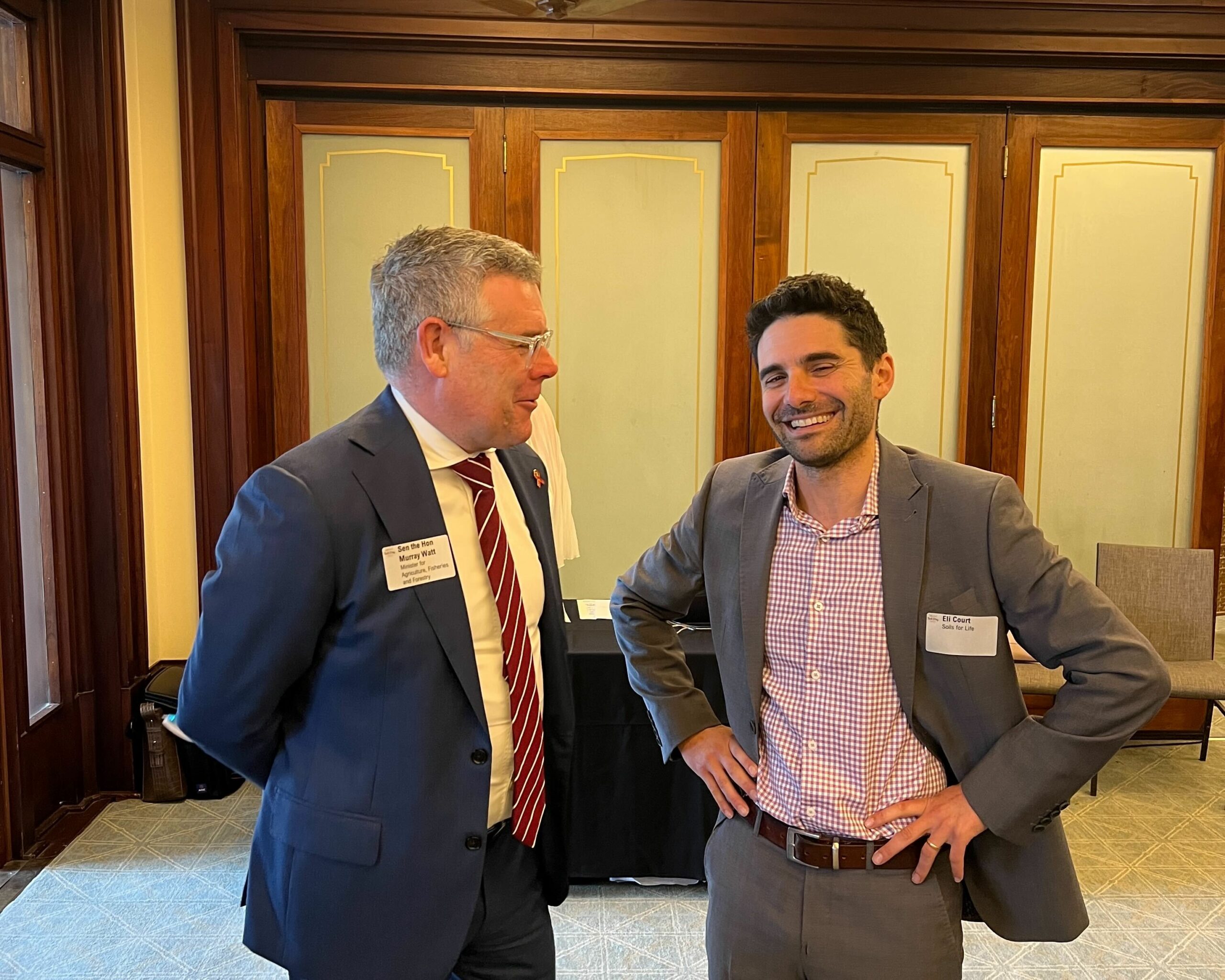Remarks by Soils for Life CEO, delivered to Sustainable Agriculture Roundtable hosted by Agriculture Minister Murray Watt
In preparation for this Roundtable I reached out to a few farmers from Soils for Life’s Australia-wide network, and the comments I have to make are based on the responses I received from them.
January 2023
What success looks like
Minister, you have asked the question: “If we want to build an even more sustainable agriculture industry, what does success look like?” I was recently talking with Victorian cropper and mixed farmer Grant Sims, who was a winner of the Weekly Times Farmer of the Year Award back in 2012. Grant was talking about how he has built the health of his business by restoring the life and health of his soil and his landscape. His costs have plummeted, his business is more resilient, he’s made it through this season without needing to apply any fungicide, which is extraordinary in such a wet year.
Most of the time though, he talked about the life that’s come back into his soils, and how he’s changed his perception of his job. He now sees his job as feeding the underground livestock as he called it – so that it can feed the plants, and so he can keep producing healthy food into the future. We know that the future will bring more frequent and more severe extreme weather, and healthy soils and landscapes means greater resilience. I mention this story because some version of this story is the vision of the future for farming that so many of our farmers describe.

Senator the Hon. Murray Watt, Minister for Agriculture, Fisheries and Forestry, having a yarn with Soils for Life CEO Eli Court.
Some of the key points from our farmers
1. It’s not necessarily a zero sum game between productivity and the environment
A common thread that comes up in many of our conversations with innovative farmers is that we need to stop thinking of production and environmental improvement as mutually exclusive or a zero sum game – we can have both, and certainly the experience of our case study farmers is that with careful management we can have precisely the opposite of a zero sum game – we can have agricultural systems where the production can actually enhance the ecology and vice versa
- To do that we do need to move beyond marginal improvements or efficiency gains: for example, for grazing properties, instead of just thinking about fencing out thin tree corridors on farms where animals are excluded, and the biodiversity is ‘over there’… this is good but not up to the challenge of reversing biodiversity loss.. Instead we need to think about integration of trees, vegetation, plant diversity and below-ground soil biodiversity in the productive areas of the farms themselves
- And we need to change our thinking about how to use landscapes. One of our case study farmers described this to me as looking at the landscape and asking: “How can I add a profitable enterprise that will enhance the biodiversity of this landscape?”
2. Changing practices involves risk and requires investment
The big issue for farmers is changing practices involves risk and requires investment – of time, energy and money. They need support to get to the point where they are confident to take those risks, and make those investments. Government has a critical role in supporting initiatives that do this.
What we know absolutely is that farmer-to-farmer is the best way to communicate.
With that in mind, we see three key strategies to support practice change:
- Case studies: Sharing the experiences of farmers about their own practice change, and how they have achieved it, and the results they’ve seen – farmers need to see and hear from someone like them who has tried something and shared the results.
- Landscape literacy: There’s no recipe for restoring soil and landscape health – there are as many ways as there are different farmers and farms. What we need to invest in is farmer capability to understand what’s happening in their own unique context, which enables them to diagnose issues, make informed decisions about management practices, observe the changing landscape, and adapt accordingly. And because there’s no recipe, we need to measure outcomes (economic, social and environmental) rather than practices, because different practices will be suited to different contexts.
- Social infrastructure: Many tools and frameworks exist for on-farm monitoring, but providing tools and frameworks is not enough; what we all need – farmers are no different – is community around us to share what we’re observing, to bounce ideas and learnings off each other. Building the social infrastructure and community support for changed practices, a lot of this can build off the social infrastructure provided in many places by Landcare and NRM groups. Combined with a national communication strategy about importance of soil and landscape health for both farming and as a national asset.
While we agree with comments from others on the Roundtable that financial incentives are important, we would caution against a singular focus on carbon offset revenue. Building carbon in agricultural landscapes is a good idea for all the reasons we described, only one of which is storing carbon to mitigate climate change.
3. Implement the National Soil Strategy and Action Plan
Soils for Life is obviously focused on healthy soils, because healthy soil is the foundation for our agriculture, for biodiversity above and below ground, and for all the essential natural services that we rely on, not least water. Healthy, functioning soils store water by acting as a sponge, decreasing reliance on rainfall or external sources of water, and therefore can reduce the impact of drought and enable landscapes to recover faster after drought
We are supportive of the National Soil Strategy Action Plan, we think it was a good first draft, and we think it’s critical that the Plan is implemented, with clear commitments and adequate funding.



